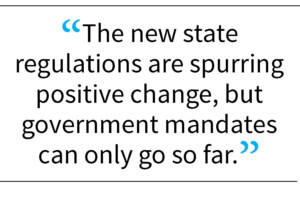Editorial: Food waste reduction: An environmental, moral imperative
Parents have a prime opportunity to instill a respect for food in the next generation
![]()
This editorial is the opinion of Gilroy Life

Up to 40 percent of food in the U.S. goes uneaten.
The recently released data on food donation rates in Santa Clara County highlights an important opportunity. More than 11.7 million pounds of edible surplus food was recovered and redirected to feed the food insecure in 2022, the first full year new regulations were in effect requiring large food businesses to donate what they would otherwise discard. This surplus food translated to more than 9.7 million meals for our hungry neighbors.
 While the progress is laudable, it also casts a harsh light on the shocking quantities of good food that are routinely thrown out in a county known globally as an innovation hub. Up to 40 percent of food in the U.S. goes uneaten. This wasting of resources and nutrition is morally indefensible when so many struggle to afford their next meal.
While the progress is laudable, it also casts a harsh light on the shocking quantities of good food that are routinely thrown out in a county known globally as an innovation hub. Up to 40 percent of food in the U.S. goes uneaten. This wasting of resources and nutrition is morally indefensible when so many struggle to afford their next meal.
The environmental impacts are also staggering. Organic waste breaks down to produce methane when buried in landfills. Diverting surplus food during the past year avoided nearly 15,000 metric tons of emissions locally, comparable to taking 3,000 cars off the road.
The new state regulations are spurring positive change, but government mandates can only go so far. Businesses must make reducing food waste an integral part of company culture. Nonprofits recovering and distributing food are heroically doing more with less even as need rises and pandemic-era funding dries up.
The call to prevent food waste is universal, but residents of Santa Clara County communities have ample opportunities to make an impact locally. For example, becoming regular donors to St. Joseph’s Food Pantry in Gilroy or Reach Out food services in Morgan Hill can ensure your surplus produce or baked goods nourish families in your neighborhood.
Faith-based groups and parent teacher organizations in Gilroy should consider holding regular food drives throughout the year, not just during the holidays. Collecting canned items and shelf-stable basics helps food assistance programs continue serving residents year-round when fresh donations dwindle.
Individuals can also volunteer at one of the several South Valley-focused meal service programs. Whether occasionally prepping ingredients, serving lunches, or delivering meals to homebound seniors, helping these nonprofits handle and distribute food is a hands-on way to be part of the solution.
Making small changes is equally worthwhile. Storing leftovers properly, planning weekly menus around what’s on hand, and freezing overripe fruit for smoothies, and requesting smaller portions are simple habits that reduce what ends up in your garbage can. Composting food scraps through companies operating locally further ensures local soil benefits from nutrients when edible rescue isn’t possible.
Parents have a prime opportunity to instill a respect for food in the next generation. Children first learn by modeling adult behaviors, so examining our own habits is the critical first step. Do you let produce languish untouched for weeks in the fridge before trashing wrinkled remains? Serve heaping portions that couldn’t possibly be finished? Push kids to take “just one more bite” after they’ve stopped eating?
Leading by example includes letting children serve themselves age-appropriate portions they’ll realistically eat. It means keeping serving bowls on the table to discourage heaping plates from the outset. If you want kids to clean their plate, start with reasonable servings instead of overwhelming quantities.
 Involve kids in preparing meals, too. They’re more likely to eat food they helped cook. Have them participate in tidying leftover ingredients back into the refrigerator or pantry so they understand where items belong. Ask children to check lower shelves for soon-to-expire foods to incorporate into upcoming meals. When leftovers or overripe items do result, walk kids through the process of determining what’s still usable, what could be frozen or preserved, and what must get composted or donated. Let them pack up nutritious excess foods for a local food pantry when volunteer opportunities allow. Wasting less as a household teaches children their actions make a difference.
Involve kids in preparing meals, too. They’re more likely to eat food they helped cook. Have them participate in tidying leftover ingredients back into the refrigerator or pantry so they understand where items belong. Ask children to check lower shelves for soon-to-expire foods to incorporate into upcoming meals. When leftovers or overripe items do result, walk kids through the process of determining what’s still usable, what could be frozen or preserved, and what must get composted or donated. Let them pack up nutritious excess foods for a local food pantry when volunteer opportunities allow. Wasting less as a household teaches children their actions make a difference.
Tackling the food system reform starts with everyday actions. Helping ensure your community makes the most of food benefits both families today and a sustainable future.
Feeding the hungry and stewarding environmental resources should not be at odds. In fact, solving these issues requires the same shift in priorities — valuing food as the precious resource it is, not carelessly handling it as disposable waste. As the technology epicenter of the world, we can and must lead the way toward zero food waste.
